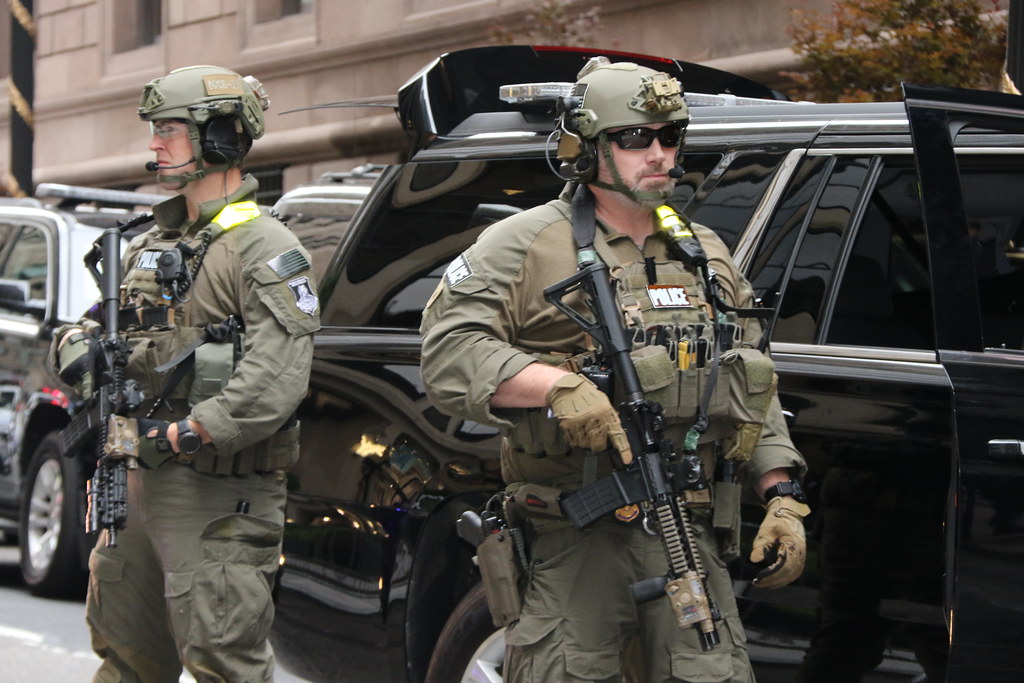Protecting Diplomats Following Soleimani’s Death
In the wake of Qassem Soleimani’s death, the global threat posed by Iran and its proxies to Americans creates a somewhat novel challenge for the Diplomatic Security Service, the law enforcement arm of the U.S. Department of State.

Published by The Lawfare Institute
in Cooperation With

The recent siege at the U.S. Embassy in Baghdad and subsequent threats of retaliation from Iran and its proxies following the Jan. 3 U.S. military operation that killed commander of Iran’s Quds Force Qassem Soleimani are vivid reminders that the world is often a dangerous place for American diplomats. In the coming days, American diplomats and civilians face an increased risk of further violent social unrest and ordnance targeting U.S. military and diplomatic facilities. In more extreme scenarios, previous Iranian actions indicate Americans could be targeted for kidnapping, murder, bombings, cyberattacks and other violence.
In the wake of Soleimani’s death, the U.S. government will be assessing the threat posed by Iran and its proxies in light of the expected retaliation. Soleimani’s death does not change Iranian capability to launch attacks, though it could change Tehran’s intent to use its capability against U.S. interests. This poses a somewhat novel challenge for the Diplomatic Security Service, the law enforcement arm of the U.S. Department of State.
Under the Vienna Convention, host governments are responsible for protecting diplomats in the host country. But experience has shown the U.S. government often cannot rely on host government protection alone—something that was just demonstrated in Baghdad. To fill this gap, the Diplomatic Security Service has statutory responsibility under U.S. law to protect official Americans abroad. At least one of the 2,400 special agents in the Bureau of Diplomatic Security (DS) are posted in nearly all U.S. embassies and consulates, serving as regional security officers—the chief law enforcement authority in an embassy in charge of coordinating security and law enforcement activities in the host country for all U.S. government agencies.
Tehran and its proxies have built a wide range of resources around the world, meaning DS must evaluate potential targets and suspicious actors globally. Unlike threats following the deaths of al-Qaeda leader Osama bin Laden and Islamic State leader Abu Bakr al-Baghdadi, Soleimani’s Quds Force—a component of Iran’s Islamic Revolutionary Guard Corps (IRGC)—and some Iranian proxy actors enjoy the resources of a nation-state. They can thus tap those resources and support of the Iranian government, raising the risk of targeted attacks carried out by better-trained and -controlled militants with more sophisticated tradecraft. Even though al-Qaeda and the Islamic State hold or held some sway over like-minded franchise organizations that could carry out deadly attacks in multiple geographic areas, such as al-Qaeda in the Arabian Peninsula or the Islamic State West Africa Province, sometimes known as Boko Haram, these group’s training and resources lag far behind that of a state-sponsored organization like the IRGC or even some of Iran's more directly coordinated and funded proxy organizations like Hezbollah. Operatives for proxy groups like Hezbollah have the financial, operational and logistical support of IRGC and Iranian Ministry of Intelligence officers posted at Iranian diplomatic posts across the globe. Unlike al-Qaeda or the Islamic State, Hezbollah operatives can receive bulk cash, weapons and explosives shipped in secured diplomatic mail shipments that are immune from search and seizure, making their transit much more difficult to track and intercept.
In examining the potential for retaliatory strikes, DS must evaluate a wide variety of tactics, target sets and locations within Tehran’s known and suspected capabilities. Geographically, the threat is much more acute in Iran’s near abroad, but Tehran’s previous actions show that DS cannot focus its attention exclusively on government personnel and facilities in the Middle East. Unlike more traditional military forces, Iran and its proxies haven’t hesitated to expand their attacks beyond government and military targets, instead carrying out bombings targeting civilians in multiple regions—like the 2012 bombing of a bus of Israeli tourists in Burgas, Bulgaria, or the 1994 bombing of the Asociación Mutual Israelita Argentina, a Jewish community center, in Buenos Aires, Argentina. Iranian proxies in recent years have also carried out attacks or had plots thwarted in Azerbaijan; Georgia; India; Nigeria; Thailand; the United Kingdom; and Washington, D.C.
DS processes for assessing and responding to threats have evolved significantly in the past several decades. Historically, the Diplomatic Security Service has learned hard lessons from past security incidents like the 1976 killings of U.S. Ambassador Francis Meloy and diplomat Robert Waring in Beirut and the 1979 murder of Ambassador Adolph Dubs in Afghanistan. In 1979, the mob seizures of U.S. diplomatic facilities in Tehran and Islamabad caused the organization to rethink contingency planning and protection, but it took horrific embassy bombings in Beirut and Kuwait in 1983 and 1984 for radical change to occur, enacted by the Omnibus Diplomatic Security Act and Anti-Terrorism Act of 1986. That law mandated several physical security measures at facilities, including expanding and enhancing the physical security perimeter around protected facilities to limit public access and other building construction regulations, in addition to significant increases in the number of DS agents and resources. The 1984 kidnapping of William F. Buckley, the American CIA station chief in Beirut, also drove changes in protection for diplomats, while the 1998 bombings of U.S. embassies in Nairobi, Kenya, and Dar es Salaam, Tanzania, were reminders that attacks can occur in locations once deemed a low threat for terrorism. More recently, the 2012 killing of U.S. Ambassador Christopher Stevens in Benghazi, Libya, led to more changes in DS, including better strategic and interagency contingency planning and much closer coordination with military partners.
Today, DS takes a more strategic planning approach to addressing the threat, both proactively and reactively. While some decisions and responses are centralized at DS headquarters in Washington, many decisions are made at posts abroad. This enhances the ability of the ambassador, regional security officers and the Emergency Action Committee at each post to address tactical threats and implement countermeasures specific to their region, facilities and personnel.
In the areas facing the highest threat today, such as Iraq, Lebanon, Saudi Arabia and Bahrain, DS will be considering a variety of measures that will enable critical diplomatic work to continue, while maintaining a safe and secure environment for diplomats and their family members. Each will specifically consider the threat of kidnapping, especially in light of previous Iranian-sponsored hostage taking. This threat is particularly problematic since the vast majority of diplomats and their family members do not live in protected compounds, creating vulnerabilities in their daily lives and activities. DS will likely consider evacuating family members and personnel noncritical to the current mission, along with restrictions on movement. Where appropriate, regional security officers will work with host nation authorities to augment security provided by host country security forces. The Diplomatic Security Service can also call on highly trained and specialized DS Mobile Security Deployment teams to provide fast and efficient security support in high-threat environments and crisis scenarios.
As anyone who has visited a U.S. embassy knows, the Diplomatic Security Service has a long history working with the Marine Security Guard detachments who are present at embassies to provide security for American personnel and facilities and to protect classified information. Their primary focus is ensuring security within the embassy compound. Regional security officers operationally manage Marine Security Guard detachments and continually prepare for threats; their preparations are ramped up during times of heightened tensions. DS can also request the deployment of specially trained Marine Security Augmentation Units, small teams of U.S. marines temporarily deployed to supplement readiness and further secure the embassy compound from external threats. In critical threat situations like the recent siege at the U.S. Embassy in Baghdad, specialized units called Special Purpose Marine Air-Ground Task Force-Crisis Response can be deployed. While a Marine Security Augmentation Unit is primarily meant to provide additional personnel support, the Special Purpose Marine Air-Ground Task Force-Crisis Response units also deploy specialized equipment that varies based on the location and type of threat. The units can provide compound defense via air, ground and amphibious operations to quickly and efficiently secure a larger area around the embassy and deploy additional personnel to handle crisis situations.
While high-threat areas will receive greater attention, DS will also be evaluating the threat of retaliation in areas where Iran is not as active. In these countries, regional security officers will work with the full Emergency Action Committee to evaluate all aspects of the threat environment, with a special focus on monitoring softer targets. To better monitor potential threats, in addition to coordinating with host nation security forces, DS has enhanced coordination with entities outside official diplomatic channels, including coordination with the U.S. private sector, schools and other private entities. This coordination enhances information sharing and can provide valuable intelligence, indications and warnings of threats to official Americans.
DS doesn’t only react to threats: It also continually and proactively builds capacity to respond to potential threats and hardens existing security measures. The U.S. Embassy compound in Baghdad today is a far more secure facility than the U.S. Embassy in Beirut in 1983. In light of hardened security measures at government facilities, the threat has shifted in recent years toward soft targets outside embassy compounds, such as hotels, restaurants, schools and other public spaces frequented by diplomats, prompting DS to build additional capabilities to protect those harder-to-protect areas. This is especially critical in areas that do not face the highest threat levels.
Following attacks on U.S. diplomatic facilities in Benghazi and Tunis, Tunisia, in 2012, DS implemented a number of proactive measures to assess and mitigate threats at posts around the world. In addition to measures taken to augment facility security directly, congressionally appropriated funds have helped DS to develop host nation security forces to aid in the protection of embassy compounds. The department’s Antiterrorism Assistance Program has developed an initiative known as the Special Program for Embassy Augmentation and Response team that has been implemented and used successfully in several countries, including Kenya and Mali, to train and equip specialized host country units that can be deployed quickly to respond to a crisis at the embassy or in the community.
DS has also expanded its internal training programs, building a new Foreign Affairs Security Training Center in Blackstone, Virginia, to address new areas of tactical training for agents, like dealing with fire used as a weapon, compound defense, civil unrest and other problems unique to high-threat environments. In addition to training agents, DS also now directly provides security awareness and counterterrorism training to all State Department foreign service officers and other U.S. government employees before deployment to an overseas posting.
DS understands the threat Iran and its proxies pose to U.S. embassies and diplomats better than most U.S. government agencies and is well positioned to protect U.S. government interests abroad in the current dangerous environment. The Iranian-sponsored attacks targeting the U.S. embassies in Beirut and Kuwait in 1983 were not only pivotal moments in the course of modern-day terrorism—they also changed the trajectory of DS as an organization. As the U.S. military, diplomats and DS face increasing risks from a familiar adversary, the work of diplomacy and protecting American diplomats has never been more important.




